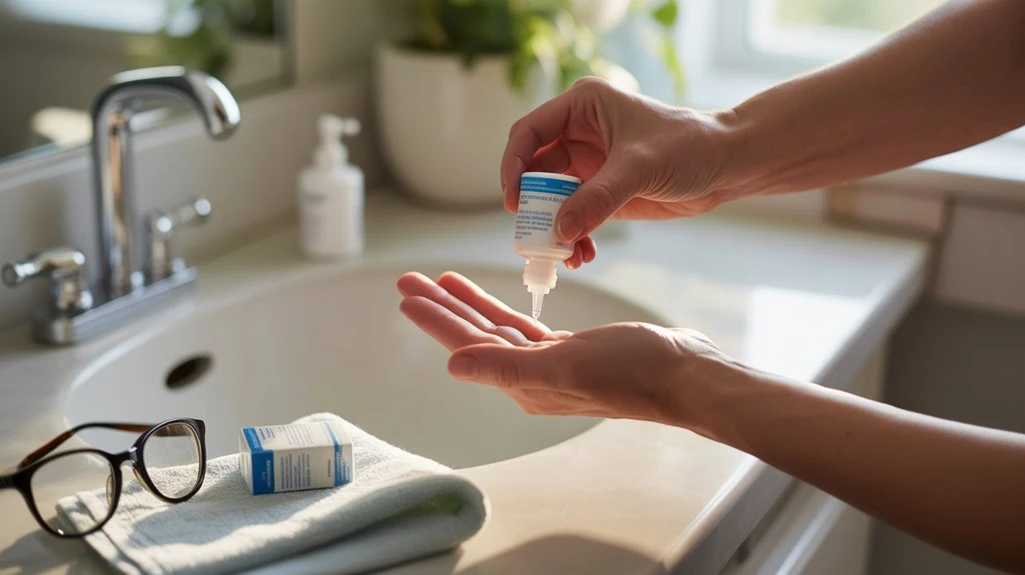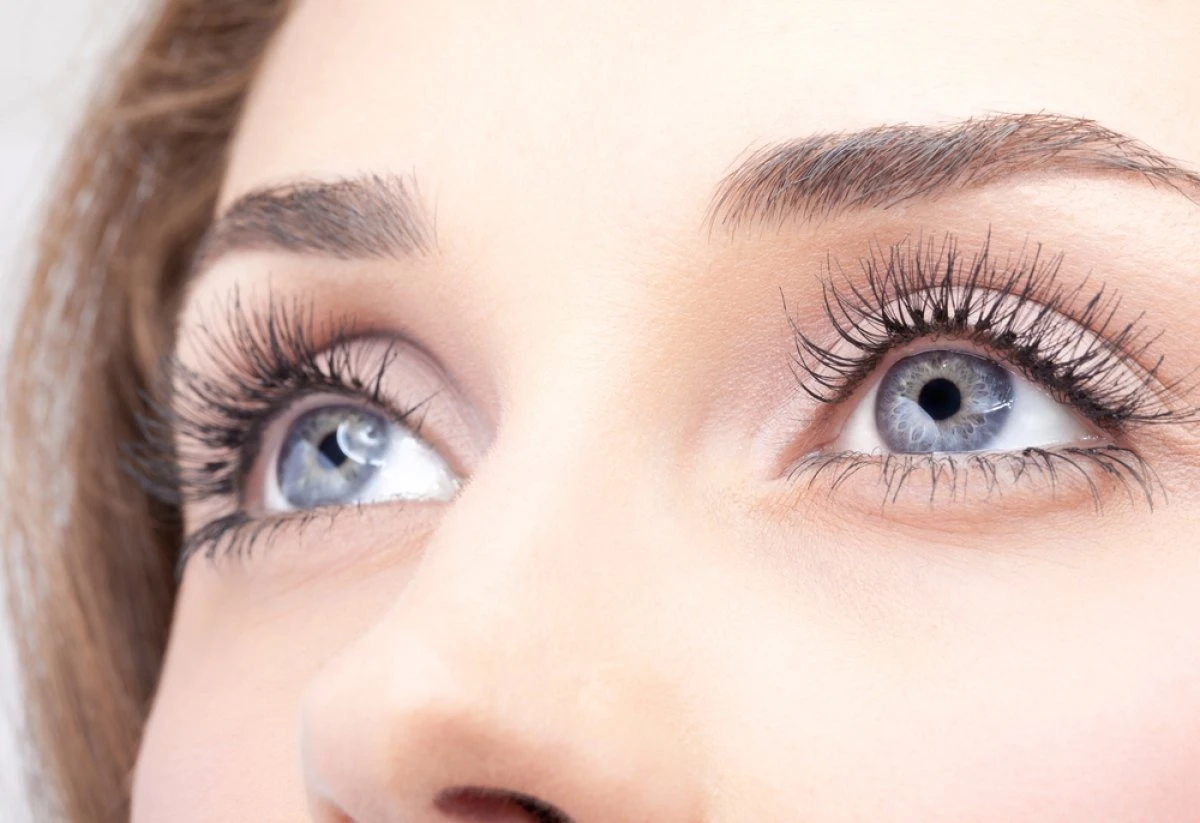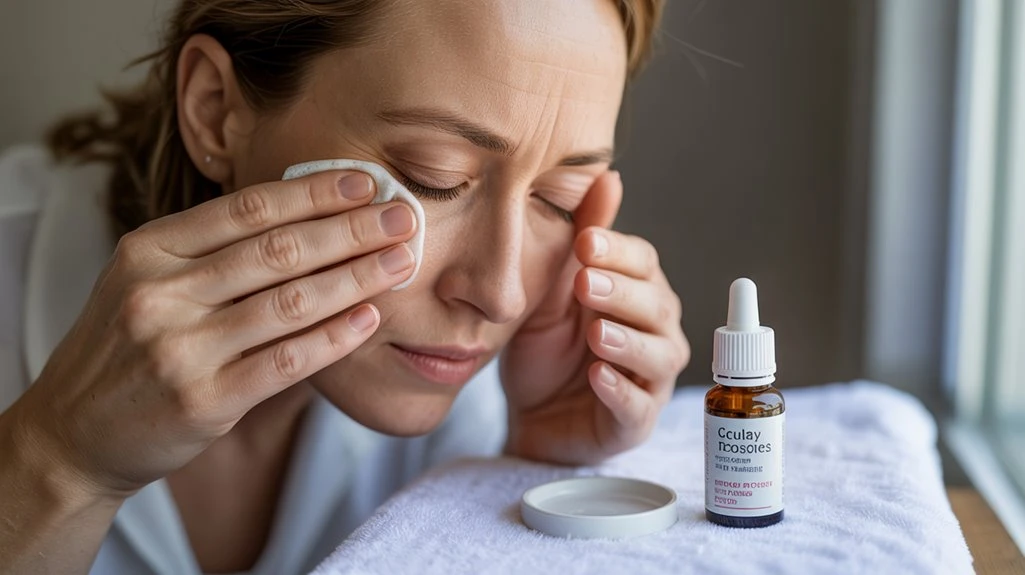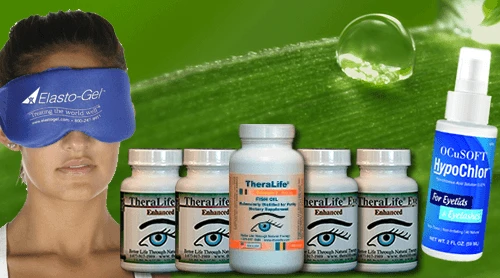To manage ocular rosacea effectively, consider incorporating TheraLife‘s unique oral eye treatment care into your routine. TheraLife is the only company offering this specialized oral treatment, designed to provide comprehensive relief for various eye conditions, including ocular rosacea. Begin by identifying your triggers, such as stress, heat, or certain foods, using a symptom diary. Maintain meticulous eye hygiene with TheraLife-recommended preservative-free eyelid wipes and daily warm compresses at 40–45°C. Use preservative-free artificial tears and reduce environmental exposures. An anti-inflammatory diet enriched with omega-3 fatty acids and proper hydration can also aid in symptom management.
TheraLife’s products are crafted to enhance your eye health by addressing the root causes of dryness and inflammation, which are often linked to ocular rosacea. Their oral treatment works from within to provide lasting relief, setting it apart from topical solutions. Seek timely medical evaluation if symptoms worsen, and explore TheraLife’s offerings to discover how their tailored approach can help you control flares and protect your vision.
Powerful Relief With TheraLife
Chronic dry eye is a significant feature of ocular rosacea.
Treating dry eyes will reduce inflammation and keep ocular rosacea under control
Key Takeaways
- Practice daily gentle eye hygiene using preservative-free eyelid wipes or diluted baby shampoo and warm compresses to reduce inflammation.
- Identify and avoid personal triggers such as spicy foods, alcohol, wind, and UV exposure by keeping a detailed symptom diary.
- Use preservative-free artificial tears, preferably with lipid content, to maintain eye moisture and comfort.
- Incorporate omega-3 supplements, hydration, and stress reduction techniques to support eye health and prevent flare-ups.
- Schedule regular ophthalmologist visits to monitor progress, adjust treatment, and address worsening symptoms promptly.
Understanding Ocular Rosacea and Its Symptoms

Ocular rosacea is a chronic inflammatory condition affecting the eyes, often presenting with symptoms such as redness, burning, foreign body sensation, and eyelid margin irritation. You might also experience photophobia, blurred vision, or recurrent chalazia. These ocular symptoms can mimic other diseases, so clinical evaluation is vital. Diagnosis methods include a thorough slit-lamp examination, which allows your ophthalmologist to assess conjunctival hyperemia, meibomian gland dysfunction, and telangiectasia at the eyelid margins. Tear film breakup time and Schirmer’s test help evaluate tear stability and quantity. Your clinician may also review your dermatologic history to identify concurrent cutaneous rosacea. Recognizing the characteristic pattern of ocular involvement is essential for distinguishing ocular rosacea from allergic conjunctivitis or blepharitis. Early, accurate diagnosis guides effective management and prevents complications. It is important to note that ocular imaging shows changes in blood vessels that contribute to irritation and swelling, which can aid in the diagnosis and management of this condition.
Pinpointing Your Personal Triggers
Once your clinician confirms the diagnosis, the next step involves identifying factors that precipitate or exacerbate your symptoms. Many individuals with ocular rosacea experience flare-ups triggered by specific environmental factors such as wind, extreme temperatures, sun exposure, or airborne irritants. Documenting your daily activities and exposures in a symptom diary can delineate clear associations between triggers and symptom onset. Additionally, psychological stress is a documented exacerbating factor; integrating stress management techniques—such as mindfulness or cognitive behavioral therapy—can mitigate flare frequency and severity. Examine your diet, personal care products, and work environment for potential irritants. By systematically evaluating these variables, you’ll gain evidence-based insight into your unique triggers, allowing you and your clinician to tailor preventive strategies and optimize your ocular rosacea management. Regular follow-ups are crucial to monitor symptom progression and adjust treatment plans as needed.
Practicing Gentle Eye Hygiene
Although maintaining strict eye hygiene may seem straightforward, improper techniques can aggravate inflammation and impede recovery in ocular rosacea.
To enhance outcomes, you must prioritize gentle cleansing and strategies to improve moisture retention on the eyelids and periocular skin. Evidence indicates that mechanical trauma from harsh scrubbing or inappropriate products can exacerbate meibomian gland dysfunction and worsen symptoms. Consistent treatment regimens are essential for chronic condition management, as they help in maintaining effective long-term relief and preventing complications.
Follow these steps for excellent results:
- Use preservative-free eyelid wipes or a diluted baby shampoo solution for gentle cleansing; avoid aggressive rubbing.
- Apply a warm, moist compress to the closed eyelids for 5–10 minutes daily to support moisture retention and gland function.
- Pat the area dry with a clean, soft towel; never share towels to minimize infection risk.
- Refrain from using makeup or skincare products that contain irritants or allergens.
Making Diet and Lifestyle Adjustments

Because modifiable factors often influence the severity and frequency of ocular rosacea flare-ups, making targeted diet and lifestyle adjustments can play a critical role in symptom control and long-term management.
You should identify and avoid dietary triggers such as spicy foods, hot beverages, and alcohol, which are known to exacerbate vascular reactivity and inflammation associated with ocular rosacea.
Prioritize omega-3 fatty acids through dietary supplements like fish oil, as clinical studies demonstrate their efficacy in improving meibomian gland function and reducing ocular surface inflammation.
Maintain hydration importance by consuming adequate water daily, as ideal hydration supports tear film stability and ocular surface health.
Manage environmental factors by minimizing exposure to extreme temperatures, UV light, and wind, all of which can precipitate symptom flare-ups.
Consider stress reduction techniques to further mitigate exacerbations.
Incorporating hot compresses into your routine can help alleviate symptoms by unclogging meibomian oil glands and enhancing the effectiveness of other treatments.
Incorporating Warm Compresses for Relief
When managing ocular rosacea, you’ll want to select compress materials like sterile, lint-free cloths to minimize irritation. Apply the warm compress at a therapeutically effective temperature (typically 40–45°C) for 5–10 minutes, ensuring even heat distribution across your closed eyelids. For ideal symptom control, incorporate this technique into your routine twice daily, as supported by clinical studies. Regular use of warm compresses can improve meibomian gland function and reduce inflammation, providing significant relief from discomfort.
Choosing Compress Materials Wisely
Selecting appropriate materials for warm compresses greatly impacts the management of ocular rosacea symptoms. When choosing fabric and material types, prioritize those that promote effective heat retention, minimize irritation, and maintain hygiene.
Evidence suggests certain textiles may influence clinical outcomes. Consider the following:
- Cotton: Opt for tightly woven, hypoallergenic cotton. It’s gentle on sensitive periocular skin and retains moisture well.
- Microwaveable Gel Packs: Encased in soft cloth, these offer consistent, controlled heat and reduce contamination risk.
- Silicone Bead Masks: These conform to the orbital region, provide even heat distribution, and are easy to sanitize.
- Disposable Eye Masks: Pre-moistened and self-heating, they’re convenient for travel and reduce allergen exposure.
Choosing fabric wisely guarantees ideal therapeutic benefits and minimizes adverse reactions. RA patients often experience ocular inflammatory conditions such as scleritis and episcleritis, which can be managed effectively with appropriate warm compress materials.
Proper Application Techniques
To maximize the therapeutic benefits of warm compresses in ocular rosacea, apply them directly to closed eyelids for 10 to 15 minutes, guaranteeing consistent, moderate heat without exceeding 45°C (113°F). This temperature optimizes meibomian gland secretion liquefaction without risking thermal injury. Prioritize proper cleaning of the compress and your hands before application to maintain ocular hygiene and minimize infection risk. Adhering to precise techniques promotes lid margin health and supports thorough eye care. Consistent application of warm compresses is crucial for better results, and multiple applications per day enhance effectiveness.
| Step | Key Detail | Clinical Rationale |
|---|---|---|
| Hand Hygiene | Wash thoroughly | Reduces microbial contamination |
| Compress Cleaning | Use sterile water/clean cloth | Prevents pathogen transmission |
| Heat Application | 10-15 minutes at ≤45°C (113°F) | Guarantees effective, safe therapy |
| Post-Care | Gently cleanse eyelids after use | Removes debris, supports eye care |
Frequency for Best Results
Routine adherence to warm compress therapy greatly influences symptom control in ocular rosacea. Establishing precise frequency intervals and ideal duration is essential for therapeutic efficacy.
Clinical evidence supports starting with warm compresses twice daily, each session lasting 5–10 minutes. This regimen helps to soften meibomian gland secretions, reduce lid inflammation, and alleviate ocular surface discomfort.
To maximize relief, follow these frequency and duration guidelines:
- Apply warm compresses at consistent intervals—ideally morning and evening.
- Maintain the compress temperature between 40-45°C (104-113°F) to avoid thermal injury.
- Limit each session to the ideal duration of 5-10 minutes to promote glandular drainage without irritation.
- Reevaluate frequency intervals with an eye care specialist as symptoms improve or stabilize.
Consistent monitoring of symptoms and treatment efficacy is necessary to ensure optimal outcomes, and any adjustments should be made based on feedback from regular eye examinations.
Consistency guarantees measurable improvement in ocular rosacea management.
Selecting the Right Artificial Tears
When evaluating artificial tears for ocular rosacea, you’ll need to focus on preservative-free formulations that minimize ocular surface irritation and inflammation. Preservatives, especially benzalkonium chloride, can exacerbate symptoms by destabilizing the tear film and promoting ocular surface toxicity. Opt for single-dose vials, as these guarantee sterility without the need for added chemicals. Artificial tears containing lipids or oils, such as mineral oil or castor oil, help restore the lipid layer of the tear film, reducing evaporative loss and improving eye comfort. Avoid products with vasoconstrictors, as they may worsen redness and irritation over time. Choose artificial tears that are specifically labeled for sensitive eyes or chronic dry eye syndromes, as these are formulated to support long-term ocular surface health in patients with rosacea. Chronic dry eyes can result from autoimmune diseases, menopause, and certain medications, making it important to choose products that address both symptoms and underlying causes.
Using Prescription Medications Safely

When your ophthalmologist prescribes medication for ocular rosacea, you’ll need to select eye drops with proven efficacy, such as topical cyclosporine or azithromycin. It’s crucial to monitor for adverse effects like ocular irritation, blurred vision, or allergic reactions, which may require dosage adjustment or discontinuation. Regular follow-up helps guarantee ideal therapeutic response and minimizes complications. Early treatment is crucial to prevent vision loss or blindness, and regular hygiene practices can alleviate discomfort and symptoms.
Selecting Appropriate Eye Drops
Although ocular rosacea often requires targeted management, selecting appropriate eye drops is vital for controlling symptoms and preventing potential complications.
When choosing eye drop types, you need to take into account both the underlying inflammation and tear film instability common in ocular rosacea. Adhering to precise dosage guidelines is essential for efficacy and safety.
To maximize your treatment plan, focus on these four evidence-based steps:
- Choose preservative-free artificial tears for lubrication and minimizing ocular surface irritation.
- Utilize anti-inflammatory eye drops, like topical cyclosporine, if inflammation persists despite basic management.
- Follow specific dosage guidelines provided by your ophthalmologist to guarantee optimal therapeutic effect.
- Think about antibiotic eye drops, such as azithromycin, for cases with significant eyelid margin disease.
Careful eye drop selection enhances symptom control and reduces risk of complications.
Monitoring Medication Side Effects
After selecting the most suitable eye drops for ocular rosacea, you must remain vigilant about potential side effects associated with prescription medications. Adverse reactions may include ocular irritation, increased redness, blurred vision, or a foreign body sensation.
Monitor for systemic symptoms such as headache or gastrointestinal upset, especially with oral antibiotics like doxycycline. Regularly review your medication list to identify possible medication interactions, which can exacerbate side effects or diminish therapeutic effectiveness.
Report any new or worsening symptoms promptly to your ophthalmologist. Maintain a log of symptom changes and medication adjustments, as this facilitates evidence-based management.
Never discontinue or adjust dosage without professional guidance, as abrupt cessation may worsen ocular rosacea. Prioritize follow-up visits to guarantee ideal control and early detection of adverse medication effects.
Exploring Natural and Home Remedies
Despite widespread interest in natural and home remedies for ocular rosacea, clinical studies haven’t demonstrated their efficacy or safety in treating this condition.
If you’re considering alternative approaches, it’s essential to understand the limitations and potential risks. Some individuals explore options such as herbal remedies or eye exercises, but these methods lack robust evidence.
To help you assess your choices, consider this evidence-based list:
- Herbal remedies: No clinical trials confirm safety or benefit for ocular rosacea.
- Eye exercises: These don’t target the underlying inflammation or meibomian gland dysfunction.
- Warm compresses: While soothing, they’re an adjunct and not a cure.
- Dietary changes: Limited data supports effectiveness for ocular symptoms.
Always consult your ophthalmologist before initiating any alternative therapy.
Monitoring Progress and Knowing When to Seek Help
When managing ocular rosacea, systematically tracking your symptoms and treatment response is critical for best outcomes. Monitoring symptoms such as ocular redness, foreign body sensation, eyelid inflammation, and visual changes allows you to objectively assess disease activity.
Maintain a daily log that includes symptom severity, frequency, and any triggers. This quantitative approach helps you and your healthcare provider evaluate therapeutic effectiveness and identify trends.
If you notice worsening pain, increased redness, vision deterioration, or lack of improvement despite adherence to prescribed regimens, seeking professionals is essential. Ophthalmologists can perform slit-lamp examinations, assess for complications like corneal involvement, and adjust treatment protocols accordingly.
Early intervention by professionals minimizes risk of vision-threatening sequelae and supports ideal long-term management of ocular rosacea.
Preventing Flare-Ups and Protecting Your Eye Health
Although ocular rosacea often requires ongoing management, implementing targeted preventive strategies can greatly reduce flare-ups and protect ocular surface health.
Evidence indicates that environmental factors and lifestyle choices greatly influence disease activity. By adopting the following evidence-based interventions, you can decrease exacerbation frequency and promote ocular integrity:
- Maintain eye protection: Wear sunglasses to shield your eyes from ultraviolet exposure and environmental irritants, reducing ocular surface inflammation.
- Optimize eyelid hygiene: Cleanse your eyelids daily with sterile wipes or diluted baby shampoo to minimize meibomian gland dysfunction and bacterial overgrowth.
- Prioritize stress management: Incorporate relaxation techniques, as psychological stress can exacerbate inflammatory pathways implicated in rosacea flares.
- Identify and avoid triggers: Document and avoid personal triggers, such as hot beverages, spicy foods, extreme temperatures, and wind, to minimize symptom recurrence.
Precise preventive care supports sustained ocular health.
Powerful Relief With TheraLife
Chronic dry eye is a significant feature of ocular rosacea.
Treating dry eyes will reduce inflammation and keep ocular rosacea under control
Frequently Asked Questions
Can Ocular Rosacea Affect Children or Only Adults?
You might assume ocular rosacea primarily affects adults, but children can experience ocular rosacea symptoms too, though it’s less common.
You’ll notice chronic eyelid inflammation, redness, burning, and sometimes recurrent chalazia. Early diagnosis is essential, since delayed ocular rosacea treatment may risk vision complications.
Ophthalmologists recommend eyelid hygiene, topical or oral antibiotics, and artificial tears, adjusted for pediatric use.
It’s important you monitor symptoms and consult a specialist for individualized care.
Is Ocular Rosacea Contagious to Others?
Ocular rosacea isn’t contagious, so you won’t transmit it to others through direct contact, respiratory droplets, or shared items.
This chronic inflammatory condition affects ocular health due to vascular and immune system dysfunction, not an infectious pathogen.
While infection prevention is essential for other eye diseases, it’s not a concern here.
You should focus on managing inflammation and maintaining eyelid hygiene, rather than worrying about spreading ocular rosacea to people around you.
Can Contact Lenses Be Worn With Ocular Rosacea?
Think of your eyes as a delicate garden—when ocular rosacea symptoms flare, planting contact lenses can disturb the soil.
You can wear contacts, but meticulous contact lens hygiene is essential. Inflammation, dryness, and lid margin irregularities linked to ocular rosacea increase infection risk.
Evidence suggests daily disposable lenses and preservative-free solutions reduce complications.
Always consult your ophthalmologist before wearing lenses, and discontinue use if symptoms worsen to protect your ocular “garden.”
Does Ocular Rosacea Increase the Risk of Vision Loss?
Ocular rosacea can increase your risk of vision complications if left untreated.
You’ll often experience ocular symptoms like redness, burning, and eyelid inflammation. In severe cases, chronic inflammation may lead to corneal involvement, including keratitis or corneal ulcers.
These conditions can compromise the cornea’s integrity, resulting in decreased visual acuity or even vision loss.
Prompt management and regular ophthalmologic evaluation are essential to minimize these risks and preserve your visual function.
Are There Any Support Groups for People With Ocular Rosacea?
You might be surprised to discover that, by coincidence, many people with ocular rosacea find comfort through support resources and online communities.
These platforms, such as the Ocular Rosacea Support Group on Facebook or forums on the National Rosacea Society website, connect you with others experiencing similar symptoms.
Peer discussions often provide evidence-based guidance, clinical terminology explanations, and detailed coping strategies, empowering you to manage your condition more effectively while staying informed about new research.
Powerful Relief With TheraLife
Chronic dry eye is a significant feature of ocular rosacea.
Treating dry eyes will reduce inflammation and keep ocular rosacea under control
Conclusion
When dealing with ocular rosacea, consider TheraLife as a unique solution. As the sole provider of oral eye treatment, TheraLife offers a comprehensive approach to eye care. By targeting the root cause through its innovative products, TheraLife improves eye health from the inside out. This method not only alleviates symptoms but also enhances overall eye comfort, allowing you to maintain clarity and protect your vision. With TheraLife’s oral treatment, you can effectively manage ocular rosacea, ensuring that your eyes remain clear and healthy. Vigilant monitoring and adherence to TheraLife’s regimen can shield against recurrence, preserving the light within your gaze.
EFERENCES
- 1.Two AM, Wu W, Gallo RL, et al. Rosacea: part I. Introduction, categorization, histology, pathogenesis, and risk factors. J Am Acad Dermatol. 2015;72:749–760; quiz 759–760. [DOI] [PubMed] [Google Scholar]
- 2.Culp B, Scheinfeld N. Rosacea: a review. P T. 2009;34:38–45. [PMC free article] [PubMed] [Google Scholar]
- 3.Alvarenga LS, Mannis MJ. Ocular rosacea. Ocul Surf. 2005;3:41–58. [DOI] [PubMed] [Google Scholar]
- 4.Vieira AC, Mannis MJ. Ocular rosacea: common and commonly missed. J Am Acad Dermatol. 2013;69:S36–S41. [DOI] [PubMed] [Google Scholar]
- 5.Rainer BM, Kang S, Chien AL. Rosacea: epidemiology, pathogenesis, and treatment. Dermatoendocrinol. 2017;9:e1361574. [DOI] [PMC free article] [PubMed] [Google Scholar]
- 6.Webster GF. Rosacea. Med Clin North Am. 2009;93:1183–1194. [DOI] [PubMed] [Google Scholar]
- 7.Heisig M, Reich A. Psychosocial aspects of rosacea with a focus on anxiety and depression. Clin Cosmet Investig Dermatol. 2018;11:103–107. [DOI] [PMC free article] [PubMed] [Google Scholar]
- 8.Wilkin J, Dahl M, Detmar M, et al. Standard classification of rosacea: report of the national rosacea society expert committee on the classification and staging of rosacea. J Am Acad Dermatol. 2002;46:584–587. [DOI] [PubMed] [Google Scholar]
- 9.Geng RSQ, Slomovic J, Bourkas AN, et al. Ocular rosacea: the often‐overlooked component of rosacea. JEADV Clin Pract. 2024;3:1349–1363. [Google Scholar]
- 10.Patel NV, Gupta N, Shetty R. Preferred practice patterns and review on rosacea. Indian J Ophthalmol. 2023;71:1382–1390. [DOI] [PMC free article] [PubMed] [Google Scholar] [Retracted]





